Campus of Virginia Tech
| Motto | Ut Prosim (Latin) |
|---|---|
| Colors | Chicago maroon and Burnt orange[1] |
| Mascot | HokieBird |
| Website | www.vt.edu |
The main campus of Virginia Tech is located in Blacksburg, Virginia; the central campus is roughly bordered by Prices Fork Road to the northwest, Plantation Drive to the west, Main Street to the east, and U.S. Route 460 bypass to the south, although it also has several thousand acres beyond the central campus. The Virginia Tech campus consists of 130 buildings on approximately 2,600 acres (11 km2).[2][3]
National Capital Region and Branch Campus Centers
Virginia Tech's presence in the National Capital Region is continually expanding. Current locations include Alexandria, Arlington, Fairfax, Falls Church, Leesburg, Manassas, and Middleburg. The university also has several commonwealth branch campus centers: Hampton Roads (Virginia Beach), Richmond, Roanoke, and the Southwest Virginia Higher Education Center in Abingdon.[4][5] The university also owns the Center for European Studies and Architecture in Ticino, Switzerland.[6]
Main Campus Academic buildings
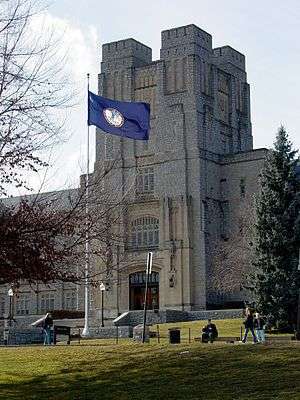

Agnew Hall
Named after Ella Graham Agnew, the first woman to receive a field appointment from the U.S. Department of Agriculture, Agnew Hall was constructed in 1940. The building is used primarily by the Department of Agriculture and Life Sciences. In 2009, a $1.6 million renovation took place which added lab space to the first floor for the Department of Biological Systems Engineering. Agnew Hall was originally constructed at a cost of $42,525.[7]
Bishop-Favrao Hall
Bishop-Favrao Hall is home to the Department of Building Construction, which is under the College of Architecture and Urban Studies (CAUS), and the Myers-Lawson School of Construction. Much of the building has its systems exposed so that students can see them and learn about the systems. Bishop-Favrao was completed in December 2007 and is named after Richard Bishop and William Favrao, the Department of Building Construction's founder and department head until 1977.[8]
Burchard Hall
Constructed in 1998 and names after Charles Burchard, the founding dean of the College of Architecture and Urban Studies between 1964 and 1979, Burchard Hall provides studio space for students in the architecture and industrial design programs. The building also provides office and classroom spaces as well as specialized studio space. Burchard Hall is actually constructed underground and has four pyramidal skylights that illuminate the studio spaces below. One can access Burchard Hall via either of the three access portals on the "roof", or through the ground-floor entrances. Burchard Hall also has a walkway connecting it to the nearby Cowgill Hall.[9]
Cowgill Hall
Cowgill Hall, located on Perry Street, is the home of Virginia Tech's College of Architecture and Urban Studies. It was named for Clinton Cowgill, who retired in 1956 after 28 years as the architecture department head.[10]
In 2006 Cowgill Hall was named the winner of the Virginia Society of the American Institute of Architects Test of Time Award. This award is presented annually to a building that has served the same function for at least 25 years.[11][12]
Davidson Hall
Davidson Hall contains office space, teaching labs, and classrooms. Originally constructed in 1928, additions to the structure were completed in 1933 and 1938; the structure was also renovated between 1964 and 1965. Named in honor of Robert James Davidson, the Dean of the Department of Applied Sciences, it was the department home for the Department of Chemistry. Davidson was a fellow of the American Association for the Advancement of Science,a member of the Washington Academy of Science, a member of the American Chemical Society, and served as the President of the National Association of Official Agricultural Chemists, in 1903. Davidson was also a delegate to the International Congress of Applied Chemistry at London, in 1909.[13]
In 2012 a $31 million renovation of Davidson Hall broke ground. When completed, Davidson Hall will have modern research laboratories, office space, new classrooms, and a 300-person auditorium. As of May 2014, substantial completion was expected in May 2014.[14]
Derring Hall
Derring Hall, a five-story building, was constructed in 1969 and contains offices, classroom space, and laboratories for primarily the biological sciences and geosciences programs at Virginia Tech. The building was named after Paul Neyron Derring, a popular administrator with the students, who was stricken blind at the age of thirteen. Derring served on the State Commission for the Visually Handicapped and served on the Blacksburg Town Council.[15]
Durham Hall
Durham Hall, a $16 million project,[16] opened in 1998 and was called "New Engineering Building", or "The NEB", until 2001. It was named in honor of Fred D. Durham, co-founder of the Dover Corporation, a Fortune 500 manufacturing company located in New York City.[17]
Norris Hall
Norris Hall is a four story (1 floor below grade) Hokie Stone academic building located between Burruss and Holden Halls.[18] The building encompasses approximately 70,000 gross square feet[19] and houses the main office for the Department of Engineering Science and Mechanics, room 219,[20] and used to house the Dean's Office for the College of Engineering, room 333,[21] The building has been home to the Department of Engineering Science and Mechanics, room 223,[22] for almost fifty years, and is named for Earl Bertram Norris, who served as dean of engineering for twenty-four years between 1928 and 1952.[23]
Norris Hall was also the location of the second shooting attack during the Virginia Tech shootings on April 16, 2007. The building was the site of 31 of the 33 fatalities (including the gunman), and all 17 wounded faculty and students. The building was closed for the rest of the 2007 spring semester, and reopened with access limited to faculty and students with legitimate business inside at remaining offices and laboratories on June 18, 2007.[24] On December 20, 2007, it was announced that the second floor of Norris would be renovated and become home to the Center for Peace Studies and Violence Prevention.[25]
On April 10, 2009, a ceremony was held to commemorate the reopening of the west wing of Norris Hall. The area consists of six reconfigured rooms and laboratories and is home to the new Center for Peace Studies and Violence Prevention as well as the Department of Engineering Science and Mechanics. The renovation project was completed in March 2009 at a cost of approximately one million dollars; many goods and services were donated by individuals and contractors in support of the project.[26] As department head of Engineering Science and Mechanics, Dr. Ishwar Puri played a leading role in the reoccupation of Norris Hall where his department is housed.[27] Among other roles, he spoke at the April 10 ceremony.[28]
Military Building
Originally constructed in 1936 and renovated in 1998, the Military Building is located on the Upper Quad. It is the base of operations for the Virginia Tech Rescue Squad and home to the Army, Navy, and Air Force ROTC programs. It also houses the College of Engineering's Joseph F. Ware, Jr. Advanced Engineering Lab.[29]
Joseph F. Ware, Jr. Advanced Engineering Lab
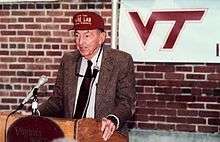
Work began on the Joseph F. Ware, Jr. Advanced Engineering Lab (Ware Lab) in 1997, in a collaboration of Joseph F. Ware, Jr., his wife Jennifer Ware, M.S.W., L.C.S.W., and Hayden Griffin, Ph.D. of Virginia Tech., and the Ware Lab was opened September 4, 1998. The Lab is named after its founder and 1937 Mechanical Engineering Alumnus Joseph F. Ware, Jr.[31] As a part of the College of Engineering, the Ware Lab is home to many student-based research and design projects. Focused on a hands-on-learning environment, students are encouraged to participate in these projects as early as their freshman year. The Klages Machine Shop is also located within the Ware Lab and is equipped with various machine tools used for project manufacturing, including two Numerical Control (CNC) Machines.[32] The lab is home to such notable teams as the Hybrid Electric Vehicle Team, Formula SAE (VT Motorsports), BOLT all electric motorcycle team and the Baja SAE team. Other teams in the lab include AISC Steel Bridge (SBT), Design Build Fly (DBF), and the Autonomous Aerial Vehicle Team (AAVT).
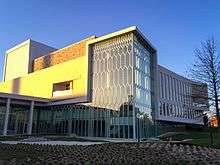
Other academic buildings
Other academic buildings on the Blacksburg campus:[33]
- Art and Design Learning Center[34]
- Cheatham Hall[35]
- Dairy Science Complex[36]
- Engel Hall
- Femoyer Hall
- Food Science and Technology
- Fralin Biotechnology Center
- Goodwin Hall (formerly 'Signature Engineering Building')[37]
- Hahn Hall (formerly Chemistry/Physics)
- Hancock Hall
- Holden Hall
- Hutcheson Hall
- Lane Hall
- Litton Reaves Hall
- Major Williams Hall
- McBryde Hall
- Newman Library
- Pamplin Hall
- Patton Hall
- Performing Arts Building
- Price Hall
- Randolph Hall
- Robeson Hall
- Sandy Hall
- Saunders Hall
- Seitz Hall
- Shanks Hall
- Smyth Hall
- Theatre 101
- Torgersen Hall
- Virginia-Maryland Regional College of Veterinary Medicine
- Wallace Hall
- Whittemore Hall
- Williams Hall
Blacksburg Academic facilities
- Agnew Hall
- Burchard Hall
- Bishop-Favrao Hall
- Davidson Hall
- Derring Hall
- Wallace Hall
- Price Hall
- Saunders Hall
- Seitz Hall
- Patton Hall
Athletics buildings

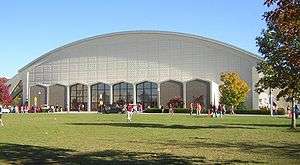
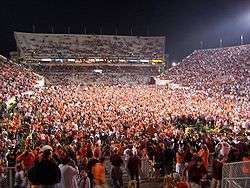
Lane Stadium
Lane Stadium is the stadium for Virginia Tech's football team. It opened in 1965 has been rated as having the "number one home field advantage" in all of college football.[39] It replaced Miles Stadium, a smaller facility that once stood directly behind the War Memorial Gym.
Cassell Coliseum
Cassell Coliseum is a 10,052-seat multi-purpose arena in Blacksburg, Virginia. The arena opened in 1961. It is home to the Virginia Tech Hokies men's and women's basketball teams.
Other athletics facilities
Additional athletic facilities:[40]
- Buford Meredith Cross Country Course
- Burrows-Burleson Tennis Center
- Christiansburg Aquatic Center
- English Field (baseball)
- Football Locker Room Facility
- Hahn Hurst Basketball Practice Center
- Indoor Practice Facility
- James C. Weaver Baseball Center
- Johnson / Miller Track Complex
- Merryman Athletic Facility
- Olympic Sports Weight Room
- Pete Dye River Course
- Rector Field House
- Tech Softball Park
- Sandra D. Thompson Field
- War Memorial Pool
- Wrestling Locker Room / Practice Facility
Residence halls
Ambler Johnston Hall
Ambler Johnston Hall is a large co-ed undergraduate residence hall located on Washington Street across from the Cassell Coliseum parking lot in what is known as the Summit Community.[18] Completed in 1968, the hall is named after Ambler Johnston, a 1904 graduate of Virginia Tech, who was the co-founder of Carneal & Johnston Architects (now Ballou Justice and Upton Architects).
The hall is divided into two wings, commonly referred to as East AJ and West AJ on campus. West AJ is the larger of the two halls and is taller by one story. The wings are connected by commons areas on the first, third, and sixth floors.
West AJ's fourth floor was the location of the first of two attacks during the Virginia Tech shootings on April 16, 2007, which resulted in the shooting deaths of a female resident and a male resident adviser. In early 2010, two students are reported to have broken onto the roof of the larger hall, West Ambler Johnston.
East Ambler Johnston reopened in the fall of 2011 as the Honors Residential College (HRC). The newly renovated East AJ features some rooms with private baths, several apartments where four student share a living room, bath, two bedrooms, and kitchen. Some traditional halls where bathroom facilities are shared by half a floor were retained; however, these too were remodeled. The latest renovation added air conditioning.
In the "bridge" that spans between East and West AJ and on the lower levels, there are meeting rooms, a student kitchen, a game room, a weight/exercise room, a theater, a library, a mail room, and laundry facilities that can be accessed through the university's "laundry web" (students can reserve machines and see if their wash/dry is done via the Internet). Also in the "bridge" is an apartment for the faculty members who are "in residence" in the HRC.
West AJ reopened in the fall of 2012. It houses the university's second Residential College with approximately 800 students and is divided into four houses: Hickory, Hawthorn, Honey Locust, and Holly. The Residential College focuses on building of community values and partnership, with each house holding its own events and having its own government structure.
Hillcrest Hall
Hilcrest Honors Community is the smallest residence hall in Virginia Tech at a student capacity of 108. Unlike most of the other residence halls on campus, it is required that all of its occupants maintain a grade point average of 3.50 and it is customary that they live in the building for the duration of their undergraduate education. The Honors Residential College in East Ambler Johnston is the only other residence hall which has the same requirements.
In addition to being a residence hall on the second and third floors, Hillcrest houses Virginia Tech's University Honors offices on the first floor and the Residence Hall Federation office in the basement. Community residents thus have the opportunity to maintain close personal relationships with the Honors staff.
Hillcrest Hall is one of very few buildings and the only residence hall at Virginia Tech not named for a person. The name is derived from its location at the crest of a hill at the east end of Virginia Tech's central Drillfield, between West Campus Drive and the Grove. It is one of the few red brick buildings on a campus known for its "Hokie Stone" architecture.
When women were integrated into VPI, it was the first and only women's dormitory and was built on what was then the far corner of the campus near several livestock barns used by the College of Agriculture that once stood near where Harper Hall now stands. When Hillcrest opened in 1940 it was promptly dubbed the "skirt barn" by VPI cadets. One of the Honors offices on the first floor used to be a "courting room" when Hillcrest Hall was the women's dormitory. Because visitation was not permitted in the residence hall, and women were not allowed to leave campus on dates, courting took place in this room. Young men would enter the room from one door and the young ladies would enter the room from another. Only a few feet away was the room where the house mother would be there to supervise.
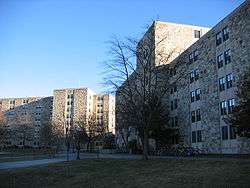
Lee Hall
Lee Hall is located on Washington Street in the Prairie Community. The building is named for Claudius Lee, an alumnus and long-time faculty member.
Lee Hall houses 824 residents on its eight floors (seven floors and ground level) including the Galileo, Hypatia, and Biological and Life Sciences (Da Vinci and Curie) theme housing programs.
In 1997 students in a history class found a page in the 1896 Bugle (Virginia Tech's student yearbook) that seemed to indicate that Claudius Lee had been president of the campus Ku Klux Klan. Some students demanded that Lee Hall be-renamed, which prompted an outcry from alumni who had known the late Claudius Lee during his long tenure as a professor. A panel named by then-president Paul Torgersen to address the issue examined the available historical records about the organization. A Klan expert hired by the university, John Kneebone, determined that the Klan was extinct in Virginia in 1896 (the modern Klan in fact dates to a 1915 rally, in Stone Mountain, Georgia), leaving open the possibility that this may have been some kind of collegiate society or fraternity attempting to appropriate the image of the nineteenth-century Klan.[41][42]
Lee Hall's penthouse, the highest point in Blacksburg, was home to the campus radio station, WUVT's, transmitter until May 2009, when the station vacated Lee Hall as part of the process of upgrading to a new transmitter and transmit location atop Price Mountain.
Oak Lane Community
The Oak Lane Community is located off of the Duck Pond and Virginia Tech Golf course. The community features 15 houses that serve 19 fraternity and sorority chapters. The community is designated as Special Purpose Housing and while the buildings are considered to be private homes, the facilities are owned and maintained by Virginia Tech Housing and Residence Life. Oak Lane is also home to a pilot program, the Innovate Entrepreneurial Living Learning Community.
Slusher Hall
The twelve-story Slusher Tower built in 1972 is the tallest building in Blacksburg. Slusher Tower, including a three-story annex, Slusher Wing, is a co-ed residence hall, home to the WING and MOSAIC theme housing programs.
The green adjacent to Slusher Tower, Slusher Wing , and Campbell Hall has long been referred to as "Slusher Beach", originating from the use of the area by students to sunbathe and play beach volleyball during warm weather.
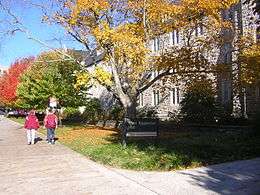
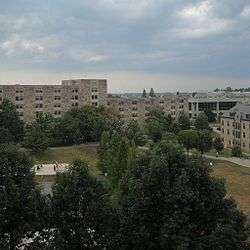
Other residence halls
- Barringer Hall – One of four remaining all-male residence halls. Located in the President's Quad and houses about 220 students. Built in 1962 it is named for Paul Brandon Barringer.
- Brodie Hall – (1957-2015) Brodie Hall opened in 1957 as a result of a renovation and addition to Barracks No. 3 (1900). Named for Col. William Mayo Brodie, professor from 1901 to 1932, Brodie Hall served as a dorm for the Corps of Cadets for 58 years. Construction for a new dorm to replace Brodie Hall began in 2015 and is expected to be completed in 2017.[43]
- Campbell Hall – The Main building, built in 1930 and originally known as Barracks No. 8, is the oldest Hokie Stone dormitory at Virginia Tech. It is home to 164 Honors and graduate students. East Campbell, originally known as Barracks No. 9, built in 1939 as a WPA project is one of three all-female residence halls.
- Cochrane Hall – A non-air-conditioned suite-style residence hall, connected to West End Market. Home to many first-year student athletes.
- Eggleston Hall – Built in 1935 as a WPA project is divided into three wings. Originally constructed as barracks when Virginia Tech was an all male military school, The Main building is now an all-female residence hall. West Eggleston is co-ed by floor and home to mostly upperclassmen. East Eggleston was once a residence hall but is now used as office space.
- Graduate Life Center at Donaldson-Brown – A former hotel and conference center. Its lowest floor is home to the graduate school's administrative offices, classrooms, meeting rooms, and a small Au Bon Pain restaurant. The remaining three floors are graduate residences.
- Harper Hall – One of the few suite-style air-conditioned residence halls on campus. Built in 1999 it houses 256 residents. Some first-year students are assigned to Harper, often as the result of allergies.
- Johnson Hall – An all-female residence hall, located in the President's Quad and houses about 190 students.
- Major Williams Hall - (1957-1995) Named after Major Lloyd W. Williams, this dorm was opened in 1957 upon the completion of an addition & renovation project that combined Barracks No. 5,(1904) & Barracks No. 6 (1927). In 1995, an addition was constructed and the building was re-purposed for academic use.[44]
- Miles Hall – An all-male residence hall built in 1964, located in the President's Quad and houses about 217 students.
- Monteith Hall – (1949) Housing for both civilian and Corp of Cadets students. Located in the Upper Quad. Monteith Hall is scheduled for demolition in 2016.
- New Residence Hall East – An air-conditioned suite-style residence hall that opened in 1999 on the Prairie; former site of Miles Stadium, Lane Stadium's predecessor.
- New Hall West – Virginia Tech's newest residence hall. Its ground floor houses live-in professional staff and its first floor is dedicated to Student Affairs offices. The top three floors are air-conditioned double-occupancy sized rooms reserved for upperclassmen.
- Newman Hall – A co-ed residence hall located in the President's Quad. Co-ed by floor and home to the WORLD and W.E.L.L theme housing program.
- O'Shaughnessy Hall – A mid-sized co-ed residence hall, by floor. Houses many upper-class students.
- Payne Hall – Virginia Tech's first air-conditioned residence hall; opened in 1993. Houses returning students and transfers only.
- Pearson Hall - (2015) Pearson Hall is named after alumni James "J" and Renae Pearson. Dedicated on November 20, 2015, Pearson Hall replaced Rasche Hall (1957-2013). Totaling 234 dorm rooms, Pearson Hall is designed to house approximately one half of the members of the Corps of Cadets.[45][46]
- Peddrew-Yates Residence Hall – (formerly New Residence Hall West) Home to the Residential Leadership Community (RLC), a suite-style air-conditioned residence hall.
- Pritchard Hall – Was the second-largest all-male residence hall on the East Coast. It became co-ed in the fall of 2009 and houses about 1,040 students, mostly freshmen. This residence hall is the biggest at Virginia Tech.
- Rasche Hall – (1957-2013) In 1957, the First Academic Building (1876) was razed to construct Rasche Hall, The new building also incorporated a remodeled Barracks No. 2. and served as a barracks for the Corps of Cadets until its demolition in 2013.[47] Pearson Hall was constructed on the site in 2014-2015.
- Thomas Hall – (1949, renovated in 1970 & 2004) A co-ed residence hall, housing 355 students, located in the Upper Quad. Thomas Hall is scheduled for demolition in 2016.
- Vawter Hall – A co-ed residence hall located in the President's quad near Owens Dining Hall and Hokie Grill. Vawter was all-male until 2013, when it was made co-ed. The floors are separated by gender: first floor is all-male, second floor is co-ed, and third floor is all female.
Living Learning Communities
Virginia Tech offers 15 living learning communities for on-campus students. They serve as an alternative experience for their residents and communities range from entrepreneurship to community service.
| Name | Community Type | Focus | Location |
|---|---|---|---|
| Curie | Academic | Physical & Quantitative Sciences | Lee Hall |
| Da Vinci | Academic | Biological and Life Sciences | Lee Hall |
| Galileo | Academic | Men in Engineering | Lee Hall |
| Hillcrest Community | Enhanced Learning | Residential Honors | Hillcrest Hall |
| Honors Residential College | Residential College | Residential Honors | East Ambler Johnston |
| Hypatia | Academic | Women in Engineering | Lee Hall |
| Innovate | Enhanced Learning | Entrepreneurship | Oak Lane |
| Morril | Enhanced Learning | Sustainability | Pritchard Hall |
| Residential College at West Ambler Johnston | Residential College | Residential Honors | West Ambler Johnston |
| Residential Leadership Community | Enhanced Learning | Leadership Development | Peddrew-Yates Hall |
| Serve | Enhanced Learning | Community/Volunteer Service | Pritchard Hall |
| The Well | Themed Housing | Substance-Free | Newman Hall |
| The World | Themed Housing | International Students | Newman Hall |
| Thrive | Enhanced Learning | Strengths Development | Pritchard Hall |
Residence Hall Federation
The Residence Hall Federation (RHF) is a University Chartered Student Organization. This organization exists to serve the 9,000 on-campus residents through hall councils in each residence hall. The RHF is composed of 23 hall councils, representing the residents of each hall, and three community councils, which represent two or more halls that share a common trait. Each individual hall council receives a programming budget of $1 per resident (or $400 if there are fewer than 400 residents) from the Student Programs office and from the RHF budget. The RHF Officer Group consists of 16 members, composing an Executive Board and a Board of Directors.
Like the Resident Advisors employed by the school, the Hall Councils produce programs that entertain and educate the residents of the buildings that they serve. These programs range from movie nights to exam study breaks. In addition, the RHF officer group also puts on campus-wide programs, under the command of the Director of Programs. Traditionally, the campus-wide programs have been Campus-Kickoff, Pizza Bonanza, and Hokies Hold'Em. The RHF also performs a number of community service projects.
Dining halls
Dietrick Dining Center
Dietrick Dining Center, or Dietrick Hall, is the largest of Virginia Tech's six dining facilities, seating 1,100 and serving on average 3,758 students daily. The building opened in 1970 at a cost of $2.8 million.[48]
The main dining area, now called "D2", was known as the "Depot at Dietrick" prior to a $6.5 million renovation completed in 2004 that converted the hall from a cafeteria-style facility to one that more closely resembles a food court.[49] The building also contains the Dietrick General Store, an extension of the University Bookstore; "Deet's Place", a coffee and ice cream shop; and the Dietrick Express, a fast food à la carte facility.
West End Market
West End Market opened in 1999 as Virginia Tech's second major food court dining facility. Adjoined to Cochrane Hall, this facility was known as Cochrane Dining Hall until it closed in 1997 for remodeling.[50]
West End Market was recognized in 1999 by the National Association of College and University Food Services as the best university specialty restaurant in the country and has been rated by the Princeton Review as one of the Top 3 school dining facilities multiple times, achieving the #1 spot in 2006.
West End Market offers students meals ranging from burgers and pizza (cooked in a their own stone hearth pizza oven), to fresh grilled fish, steaks, and lobster taken from JP's Chop House Lobster tank.[51]
Owens Hall
Owens Hall opened in 1940 as a replacement for Virginia Tech's military mess hall.
The Food Court contains twelve a la carte specialty shops. Owens Hall was voted by Joe Frett Weekly to have the "Best Philly Cheesesteaks in the U.S." In 1997, a section of the building called the Hokie Grill & Co. was remodeled to feature Chick-fil-A and Pizza Hut franchises. In its first year, the Chick-fil-A became the top-selling of all Chick-fil-A franchises located on college campuses.[52]
Owens Hall is located on Kent Street in the Lower Quad.
Turner Place
Opened in August 2012, Turner Place at Lavery Hall is the newest dining hall at Virginia Tech. It features: Atomic Pizzeria, Jamba Juice, 1872 Fire Grill, Qdoba Mexican Grill, Origami (a hibachi grill), Soup Garden, Dolci e Caffe, and Bruegger's Bagels. There is also a 256-seat dining hall that is for the Corps of Cadets.[53]
Other dining facilities
- Au Bon Pain (located at Squires Student Center)
- Burger '37 (located at Squires Student Center)
- DXpress (located at Dietrick Hall)
- Vet Med Cafe (located in the Vet Med Commons)
Miscellaneous buildings
Burruss Hall
Burruss Hall is the main administration building, it also contains a 3,003-seat auditorium and houses several departments in the College of Architecture and Urban Studies. It consists of the original building, completed in June 1936 (cost $428,404; 77,080 sq ft (7,161 m2) ); a west wing and rear addition, built in 1968 (cost $1,536,899; 60,503 sq ft (5,620.9 m2)); and an east wing, built in 1970 (cost $593,729; 20,638 sq ft (1,917.3 m2)). The cornerstone of the original building was laid at the 1935 commencement; the first commencement was held in the auditorium in June 1936. An electronic carillon, costing $28,000, was added in 1958 and was dedicated at Homecoming that year. It was originally known as the Teaching and Administration Building.
Julian Ashby Burruss (1876–1947) was President from 1919 to 1945. The first alumnus president, Burruss guided VPI through tremendous increases in faculty, student body, and degree offerings; vast growth in the physical plant; and efficient changes in administrative structure. He successfully pushed to admit women and shortened the military requirement to two years, setting the stage for a larger civilian student body. During his tenure, Radford College became the Women’s Division of VPI.
G. Burke Johnston Student Center
The G. Burke Johnston Student Center (most commonly called GBJ) contains student activities rooms also used as classrooms during the day, a Subway food court, and study areas. On the bottom floor of this three-story building is the entrance to the Pamplin tunnel, which connects this building with the adjacent Pamplin Hall; there is also a bridge on the third floor connecting it to Burruss Hall.
Perry Street Parking Deck
Completed in 2010, the Perry Street Parking Deck is a five-level parking deck that can accommodate 1,300 vehicles. Parking Services now maintains a satellite located on the first floor of the parking deck. In the spring of 2012, a $1.2 million project, funded through the American Recovery and Reinvestment Act (ARRA) of 2009, installed 480 solar panels on top of the parking deck. The solar panels cover an area of 16,000 square feet and are expected to generate about 136,000 kilowatt-hours annually, or about 13% of the total parking deck's power usage.[54]
Power plant
A campus landmark, the power plant is located on the upper quad across from Thomas Hall. Its 180-foot (55 m) chimney can be seen from many places throughout Blacksburg. The plant is a cogeneration facility that provides electricity, heat and steam for the campus.[55]
Other miscellaneous buildings
- Alumni Hall
- Armory
- Cranwell International Center
- The Grove (President's Residence)
- Health and Safety Building
- Henderson Hall
- Information/Visitors Center
- McComas Hall[56]
- Media Building
- Price House (razed 2005)[57]
- Smith House
- Solitude
- Squires Student Center
- Student Services Building
- University Bookstore
- University Club
- War Memorial Chapel
- War Memorial Gymnasium
- Wright House
Non-building campus landmarks
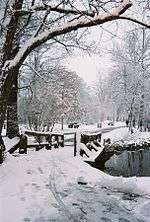
Hokie Stone
On the Blacksburg campus, the majority of the buildings incorporate Hokie Stone as a building material. Hokie Stone is a medley of different-colored limestone, often including dolomite. Each block of Hokie Stone is some combination of gray, brown, black, pink, orange, and maroon. The limestone is mined from various quarries in Southwestern Virginia, Tennessee, and Alabama, one of which has been operated by the university since the 1950s.
The Duck Pond
The Duck Pond is a man-made water feature created in the 1930s, situated along the northwest portion of the Blacksburg campus. The most notable feature is a gazebo located on its south side connected to picnic and seating areas by pedestrian pathways. It is adjacent to Solitude, a Greek-revival home built in the early 1800s, the oldest structure on campus.[58]
Gargoyles
There are 15 gargoyles which appear on Tech buildings, especially older buildings, including Hillcrest, Saunders, and Eggleston Halls. Although some, like those on the Eggleston archway, are functional, the majority are merely ornamental. Among the more distinctive gargoyles on campus are the "cowgoyles" seen on some agricultural buildings.[59]
April 16 Memorial
The April 16 Memorial is located in the center of the side of the Drillfield in front of Burruss Hall. The memorial consists of 32 Hokie Stones, one for each victim, and a stone in the center to honor all of the fallen and injured victims. On the night of April 16, 2007, students placed pieces of Hokie Stone in a semi-circle, and this then led to the creation of the present-day memorial.[60]
See also
| Wikimedia Commons has media related to Virginia Tech campus. |
References
- ↑ "The Brand Guide: Virginia Tech Identity Standards and Style Guide" (PDF). Virginia Tech. May 2013. p. 45. Retrieved September 11, 2015.
The burnt orange and Chicago maroon are the university's official colors that were adopted in 1896.
- ↑ "Virginia Tech Campus Map". Campus Maps. 2014. Archived from the original on 2014-11-23. Retrieved November 23, 2014.
- ↑ "Factbook: About the University". Virginia Polytechnic Institute and State University. 2014. Archived from the original on 2014-05-27. Retrieved May 31, 2014.
- ↑ "Extended Campus Locations". Maps & Locations. Virginia Polytechnic Institute and State University. 2014. Archived from the original on 2014-05-27. Retrieved May 31, 2014.
- ↑ "Extended Campuses". Virginia Tech Graduate School. 2014. Archived from the original on 2014-05-29. Retrieved May 31, 2014.
- ↑ "Center for European Studies and Architecture at Virginia Tech". Archived from the original on 2014-05-27. Retrieved May 31, 2014.
- ↑ "Agnew Hall". About / Buildings. Virginia Polytechnic Institute and State University. 2014. Archived from the original on 2014-01-22. Retrieved May 31, 2014.
- ↑ "Bishop-Favrao Hall". About / Buildings. Virginia Polytechnic Institute and State University. 2014. Archived from the original on 2014-01-22. Retrieved May 31, 2014.
- ↑ "Burchard Hall". About / Buildings. Virginia Polytechnic Institute and State University. 2014. Retrieved May 31, 2014.
- ↑ "Cowgill Hall". About / Buildings. Virginia Polytechnic Institute and State University. 2014. Archived from the original on 2014-01-22. Retrieved May 31, 2014.
- ↑ Chadwick, Heather Riley (May 2, 2006). "Cowgill Hall wins Virginia Society of the American Institute of Architects award". Virginia Tech News. Archived from the original on 2009-03-20. Retrieved May 31, 2014.
- ↑ Lent, Andrew. "Virginia Tech's Cowgill Hall receives architectural award". Virginia Tech's Cowgill Hall receives architectural award. Roanoke Times. Archived from the original on 2012-03-20. Retrieved June 4, 2006.
- ↑ "Davidson Hall". About / Buildings. Virginia Polytechnic Institute and State University. 2014. Archived from the original on January 22, 2014. Retrieved May 31, 2014.
- ↑ "Renovate Davidson Hall". University Design & Construction. 2014. Archived from the original on May 31, 2014. Retrieved May 31, 2014.
- ↑ "Derring Hall". About / Buildings. Virginia Polytechnic Institute and State University. 2014. Archived from the original on 2014-01-22. Retrieved May 31, 2014.
- ↑ "Engineering Facility Building Number – 126". Capital Design and Construction Dept. Virginia Polytechnic Institute and State University. August 1997. Archived from the original on 2000-07-08.
- ↑ "Durham Hall". About / Buildings. Virginia Polytechnic Institute and State University. 2014. Archived from the original on January 22, 2014. Retrieved May 31, 2014.
- 1 2 "Main Campus Map" (PDF). Virginia Polytechnic Institute and State University. 2014. Archived (PDF) from the original on 2014-04-03. Retrieved May 31, 2014.
- ↑ Hincker, Larry (June 5, 2007). "Norris Hall to begin phased reoccupation". Virginia Tech News. Archived from the original on 2013-11-05. Retrieved May 31, 2014.
- ↑ "Department of Engineering Science and Mechanics". Virginia Polytechnic Institute and State University. Archived from the original on 2007-04-25.
- ↑ "College of Engineering Dean's Office". Virginia Tech College of Engineering. 2006. Archived from the original on 2007-02-14.
- ↑ "Department of Engineering Science and Mechanics: Latest News from the ESM Department". College of Engineering. Virginia Polytechnic Institute and State University. May 22, 2014. Archived from the original on 2014-05-31. Retrieved May 31, 2014.
- ↑ "Norris Hall". About / Buildings. Virginia Polytechnic Institute and State University. 2014. Archived from the original on 2014-01-22. Retrieved May 31, 2014.
- ↑ "Virginia Tech will reopen Norris Hall". CNN.com. Associated Press. June 6, 2007. Archived from the original on 2007-06-11.
- ↑ Vargas, Theresa (December 21, 2007). "Va. Tech's Norris Hall To House Peace Center". The Washington Post. Retrieved May 31, 2014.
- ↑ Owczarski, Mark (March 31, 2009). "Norris Hall second floor to re-open April 10". Virginia Tech News. Archived from the original on 2013-05-14. Retrieved May 31, 2014.
- ↑ Puri, Ishwar (August 31, 2007). "Virginia Tech Instructor: Ready to Move Forward". Morning Edition (Interview). Interview with Inskeep, Steve. npr. Archived from the original on 2013-09-26. Retrieved May 31, 2014.
- ↑ Puri, Ishwar (April 20, 2009). Norris Hall opening: Remarks by Ishwar Puri. University Relations (Video). Virginia Polytechnic Institute and State University. Archived from the original (QuickTime) on April 16, 2010.
- ↑ "Military Building". About / Buildings. Virginia Polytechnic Institute and State University. 2014. Archived from the original on 2014-03-15. Retrieved June 2, 2014.
- ↑ Spieldenner, Bob (January 27, 2015). "Lane Hall receives national historical status". www.vtnews.vt.edu. Virginia Tech. Retrieved March 7, 2016.
- ↑ "About Joseph F. Ware, Jr.". College of Engineering. Virginia Polytechnic Institute and State University. Archived from the original on 2013-12-13. Retrieved June 1, 2014.
- ↑ "Klages Machine Shop". Joseph F. Ware Jr. Advanced Engineering Lab. Virginia Polytechnic Institute and State University. 2011–14. Archived from the original on 2013-07-02. Retrieved June 2, 2014.
- ↑ "Virginia Tech Buildings". www.vt.edu. Virginia Tech. 2016. Retrieved March 7, 2016.
- ↑ "Art and Design Learning Center". About / Buildings. Virginia Polytechnic Institute and State University. 2014. Archived from the original on 2014-01-22. Retrieved June 2, 2014.
- ↑ "Cheatham Hall". About / Buildings. Virginia Polytechnic Institute and State University. 2014. Archived from the original on 2014-01-22. Retrieved June 2, 2014.
- ↑ "Dairy Science Complex". About / Buildings. Virginia Polytechnic Institute and State University. 2014. Archived from the original on 2014-01-22. Retrieved June 2, 2014.
- ↑ "Goodwin Hall". www.vt.edu. Virginia Tech. 2014. Retrieved March 3, 2016.
- ↑ "Hokies defense scores twice". ESPN College Football Recap. November 1, 2003. Archived from the original on 2013-10-23. Retrieved June 2, 2014.
- ↑ Lavender, David (August 21, 2005). "No place like home". rivals.com. Yahoo! Sports. Archived from the original on 2014-06-02. Retrieved June 2, 2014.
- ↑ "Athletic Facilities". www.hokiesports,.com. Virginia Tech. Retrieved March 7, 2016.
- ↑ Nutter, David (November 20, 1997). "Panel reports to Torgersen on Claudius Lee". Virginia Tech Digital Library and Archives: Spectrum. Archived from the original on June 1, 2014. Retrieved June 3, 2014.
- ↑ CT Editorial Board (January 28, 2008). "Editorial: Lee Hall should keep name despite controversial past". Collegiate Times. Educational Media Company at Virginia Tech. Archived from the original on 2011-07-08.
- ↑ Spieldenner, Bob (June 8, 2015). "Brodie Hall demolition begins this week". www.vtnews.vt.edu. Virginia Tech. Retrieved March 3, 2016.
- ↑ "BUILDINGS - Major Williams Hall". www.vt.edu. Virginia Tech. Retrieved March 2, 2016.
- ↑ Raboteau, Albert Jordy III (November 11, 2015). "Virginia Tech News: Virginia Tech's Pearson Hall to open this week". www.vtnews.vt.edu. Virginia Tech. Retrieved March 2, 2016.
- ↑ Raboteau, Albert Jordy III (April 22, 2015). "New Corps of Cadets residence hall named in honor of J. and Renae Pearson". www.vtnews.vt.edu. Virginia Tech. Retrieved March 4, 2016.
- ↑ Cox, Clara B. "Rasche Hall: A plain monument to a colorful character". www.vtmag.vt.edu. Retrieved March 2, 2016.
- ↑ Student Programs – Virginia Tech – Virtual Tour
- ↑ Student Programs – Virginia Tech – Virtual Tour
- ↑ Student Programs – Virginia Tech – Virtual Tour
- ↑ Virginia Tech Magazine Feature 2
- ↑ Student Programs – Virginia Tech – Virtual Tour
- ↑ http://www.dining.vt.edu/centers/turnerplace.php
- ↑ http://www.vtnews.vt.edu/articles/2012/02/020712-tcs-solarpanels.html
- ↑ Utilities @ Virginia Tech
- ↑ "McComas Hall". www.vt.edu. March 7, 2016. 2016.
- ↑ "Relocation Plans". Virginia Tech Women's Center. 2004-09-11. Archived from the original on 2004-09-11. Retrieved 2007-04-05.
- ↑ Adams, Mason (Fall 2014). "Virginia Tech Magazine: Waterways - Inside the Duck Pond". www.vtmag.vt.edu. Volume 37, Number 1. Retrieved March 7, 2016.
- ↑ 94vtmp.pdf
- ↑ http://www.weremember.vt.edu/memorial.html
External links
- Virginia Tech Student Programs
- Virginia Tech campus construction status
- Virginia Tech maps
- Official VT buildings page
- Virginia Tech Residence Hall Federation
- Link to the April 16, 2007, school shooting
